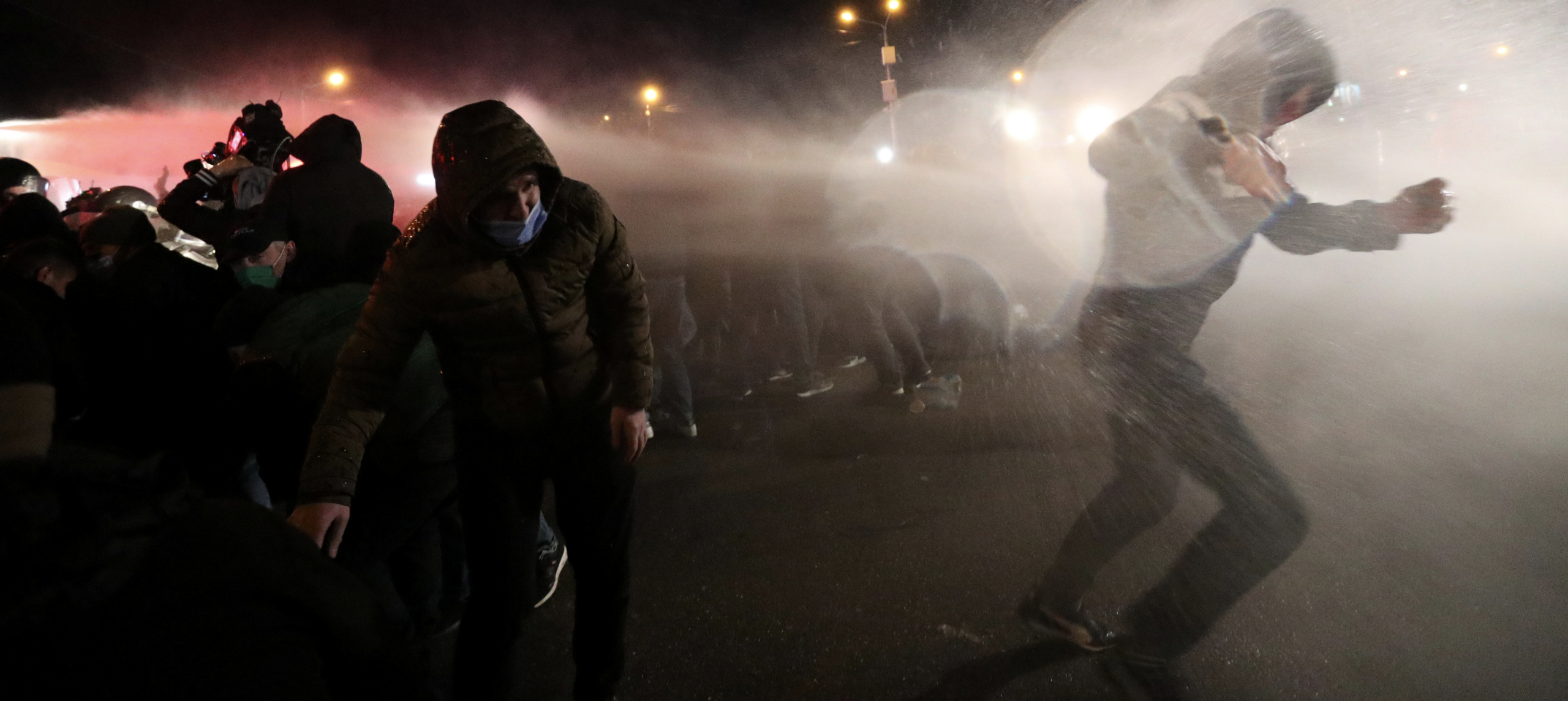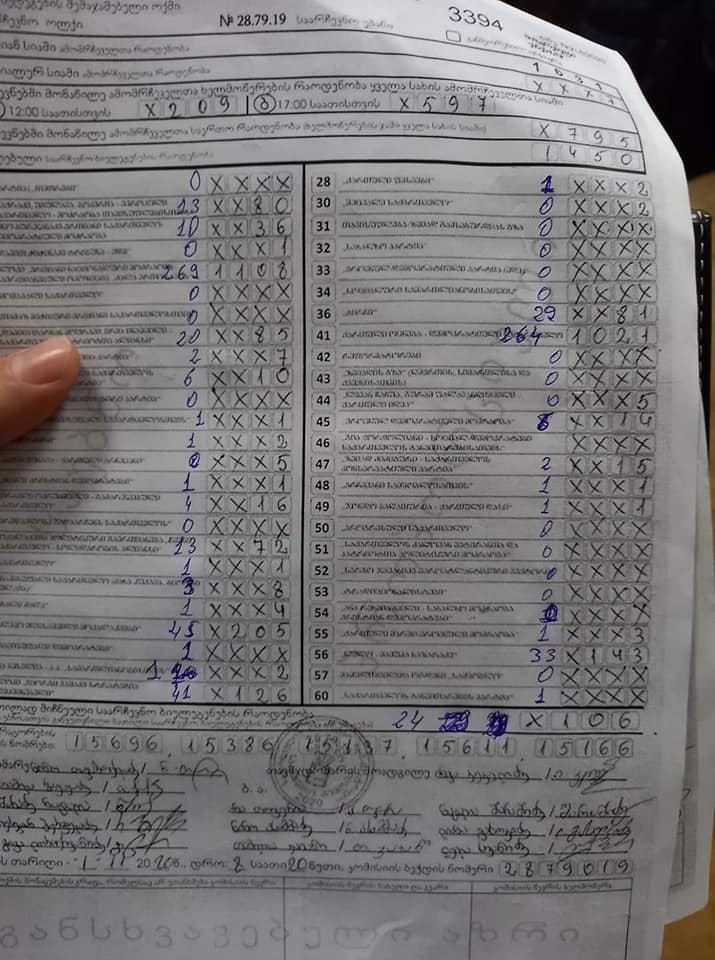
Footage surfaces online showing evidence of violations across the country of Georgia

On October 31, 2020, parliamentary elections were held in the country of Georgia. Soon after, allegations of electoral violations and voter intimidation at the polls emerged. Images of falsified summary protocols and fabricated figures, as well as video footage of various violations at polling stations, surfaced on the internet. The political opposition did not recognize the legitimacy of elections and has refused to enter the next parliament, and ongoing demonstrations across the country continue to protest the results.
The October 31 election was closely watched both domestically and internationally after demonstrations started in June 2019. While international observers’ initial assessments, specifically an OSCE statement released the following day, indicated that the elections were “competitive and overall fundamental freedoms were respected,” they also acknowledged that “pervasive allegations of pressure on voters and blurring of the line between the ruling party and the state reduced public confidence in some aspects of the process.” Subsequent statements by the National Democratic Institute and the U.S. Embassy listed numerous violations in detail and called on Georgia’s Central Election Commission to fully address them, which it has yet to fully do so.
These elections took place at a politically sensitive time, as Georgia adopted changes to its parliamentary system. The changes were spurred by protests that first erupted in June 2019, upon the visit of Russian MP Sergey Gavrilov to Georgia. The main demand of the protesters, in addition to putting an end to the Russian occupation of Georgia, was to reform the electoral system of the country and switch to a fully proportional one. This demand was backed up by the main opposition parties, local NGOs, and pro-democracy activists, as well as members of the international community; the proportional system was seen as an opportunity for ending growing polarization and forming a parliament with diverse representation.
Amid increased tensions, the chairperson of the ruling party, oligarch Bidzina Ivanishvili, promised to reform the electoral system; however, MPs from Georgian Dream, the governing party that also controlled a majority in parliament, voted down the constitutional amendments aimed at transitioning to a fully proportional system. Following new waves of protests and pressure from the international community, parliament adopted changes to the Electoral Code on June 29, 2020, switching to a 120 proportional/30 majoritarian MP system with a 1 percent minimum threshold for political parties. The new changes also set in motion the possibility of holding the 2024 parliamentary elections with the fully proportional system.
Election day 2020
Over the course of election day on October 31, a number of local watchdogs, in addition to NDI and international observers, reported numerous allegations of verbal and physical intimidation, including attacks on journalists and observers, the presence of unauthorized individuals at polling stations, and allegations of vote rigging, vote bribing, and violation of vote secrecy. As of November 4, a total of 3,000 independent election observers recorded more than 500 complaints at various polling stations. The Public Defender of Georgia, meanwhile, called on the Central Election Commission of Georgia (CEC) to provide a working environment for election observers that was safe and free of intimidation.
Tensions increased when the CEC presented the initial preliminary election results with a 7-hour delay, breaking with the timeline established in previous elections, prompting opposition parties and NGOs to suspect that manipulation had occurred in the counting process. The CEC’s preliminary results fueled more controversy, as they corresponded almost exactly to pro-governmental exit polls.
The International Society for Fair Elections and Democracy (ISFED) conducted a parallel vote tabulation that showed two important findings. First, the number of counted ballots exceeded the number of voter signatures in eight percent of the electoral precincts. Second, although these irregularities may have impacted the performance of various electoral entities, the estimated maximum impact of the election results was less than 4.1 percent.
Civil society takes vote counting into their own hands
Soon after claims emerged of votes being fabricated in favor of the ruling party, a recently created Facebook page surfaced on November 1. “Falsified tallies” (გაყალბებული ოქმები in Georgian) quickly garnered high engagement among Georgian users, as it provided screenshots of tabulated election tallies and descriptions of how they were allegedly manipulated. The Facebook page was originally created on September 4, 2020, under the name ნუ გვართმევთ ემიგრანტებს ხმის უფლებას (“Do not deprive immigrants the right to vote”) and renamed itself on November 1, the day after the elections.


Copies of local vote tallies are also available on the CEC official website, as the administrative body is obliged to publish screenshots of all collected tallies. However, NGOs and opposition leaders raised concerns that the CEC has been removing the initial falsified tallies and replacing them with corrected ones, without publishing the official amendments to hide evidence of manipulation. In general, when a particular tally is recounted and needs to be amended, the CEC must publish an officially corrected version of it to document the updated tally.

Following these concerns, Georgian Facebook users developed an online tool, watcher.ge, to provide third-party monitoring of updates to the CEC’s website. Watcher.ge automatically saves all of the official tallies uploaded on the CEC site, and sends alerts to users of any updates, such as the removal of a tally and its amended version.

Local monitoring groups also alleged that the official tallies had been manipulated. The chairman of the Georgian Young Lawyers Association (GYLA), a watchdog critically assessing the election process, shared a an example of a tally that appeared to be manipulated. According to the documentation, only 795 voters went to a particular polling station, yet the total number of votes recorded there somehow reached 3,163, meaning there were 2,368 more votes than voters who actually showed up.

Violations at the polling stations
Videos also surfaced on Facebook that showed evidence of possible vote bribing and physical confrontations at polling stations. Observers reported on various cases of verbal and physical confrontations, obstruction, and attacks against journalists and observers. Multiple NGOs have reported on alleged voter bribing outside the polling stations. Formula TV also conducted an investigation in which several citizens reported they had received 50GEL (approximately USD$20) to vote for the ruling party.
Multiple cases were also reported on violations of vote secrecy, meaning that the voters may have showed their ballots to unauthorized individuals standing nearby to confirm they were voting for a particular party. Transparency International of Georgia has also reported on the presence of unauthorized individuals at polling stations.
Cases of vote manipulation have been reported by observers and opposition candidates. Nanuka Zhorzholiani, United National Movement candidate in the city of Tskaltubo, published a video allegedly showing one voter throwing multiple ballots into a ballot box. Another video released by European Georgia party candidate Elene Khoshtaria showed a ballot box that was moved to a separate room, depriving authorized observers of their right to monitor the count.
Videos of the same individuals voting several times have also appeared on Facebook. One case was reported by opposition candidate Elene Khoshtaria, while Transparency International Georgia identified someone voting at least 10 times at the same polling station. The District Election Commission confirmed the violation but refused to annul the results, even in the face of evidence.

Another video released by TV Pirveli showed a gang gathered outside a Tbilisi polling station, threatening their cameraman. Despite the presence of several aggressive individuals, only one policeman is seen in the video — and he did not arrest or otherwise confront the men. The DFRLab identified one of the individuals shown in the video as Giorgi Dokhturishvili, a City Council member from the ruling Georgian Dream party. Though the Election Code of Georgia restricts the presence of public servants within 25 meters of the polling station, the presence of mayoral representatives at the polling stations still has the potential to create an intimidating environment and influence the casting of votes.

Violent dispersal of demonstrations
On the night of November 8–9, 2020, hundreds of demonstrators took to the streets to protest the election results. Opposition leaders and protesters first gathered in front of parliament, then moved to the Central Election Commission and demanded the resignation of its chairwoman. The police then deployed water cannons without prior warning against very small group of demonstrators. As more protesters joined, the police used the water cannons a second time. At least eight journalists were injured: five more than the three reported by the Georgian Interior Ministry. According to media reports, several protesters were also injured, while one had chemical burns in his eye, indicating that the police used tear gas or other chemical irritants along with water cannons. Video from TV Pirveli captured police aiming their water cannons directly at journalists.
.@TvPirveli footage clearly showing aimed water cannons throwing a journalist off the truck at the peaceful protest against rigged #GVote2020 on Nov 8th. pic.twitter.com/XjhLK1QibG
— Helen Khoshtaria (@Helenkhosh) November 11, 2020
The Interior Ministry justified the use of water cannons by saying that the protesters were “storming” the CEC building. Georgian Dream MP and Parliament Chairperson Irakli Talakvadze later said that the protesters attempted to take ballot papers out of the CEC building and destroy them, even though there were no ballot papers stored in the building. The Interior Ministry also tweeted doctored video footage from the demonstration as a justification of the violent dispersal of the demonstration. A deputy minister stated that the protesters were warned “numerous” times. The ministry also denied the use of tear gas, calling the reports “disinformation.”
The DFRLab analyzed footage released by the Interior Ministry and compared it to TV footage and live reporting of the protests. Analysis showed that the footage from the ministry was misleading, as it was a collection of multiple pieces of footage rather than a continuous livestream, and selectively highlighted the actions of a small group of aggressive individuals amid what were generally peaceful protests.
There were additional inconsistencies between official statements and open-source evidence from the protests. Live reporting from numerous TV channels showed police deploying water cannons without prior warning, which local NGOs assessed as a “crime,” “illegitimate,” and an “excessive use of power.”


Protesters attempted to tear #police steel cordon and break into the venues of the Central Election Commission
Video Footage: https://t.co/1rI9Cvg1YR
— MIA of Georgia (@MIAofGeorgia) November 8, 2020
Even though the doctored footage from the Interior Ministry showed several individuals kicking down a steel door, the Public Defender and civil society representatives and the lawyers assessed that the use of water cannons was “unjustified” and that the police “gravely violated the right to assembly and manifestation,” as this method is only used during mass riots that endangers citizens and the property.
Eto Buziashvili is a Research Associate, Caucasus, with the Digital Forensic Research Lab.
Sopo Gelava is a Research Associate, Caucasus, with the DFRLab.
This research is part of the #ElectionWatch Georgia project in partnership with On.ge, made possible through support from East-West Management Institute (EWMI) and US Agency for International Development (USAID). Contents of this report are the sole responsibility of the author and do not necessarily reflect the views of EWMI, USAID or US Government.
Follow along for more in-depth analysis from our #DigitalSherlocks

